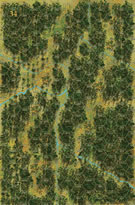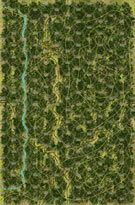|
Isurava — The Retreat Kokoda Trail #12 |
||
|---|---|---|
| (Defender) Australia | vs | Japan (Attacker) |
| Formations Involved | ||
|---|---|---|
| Australia |  |
21st Infantry Brigade |
| Japan |  |
Yazawa Detachment |

|
| Overall Rating, 4 votes |
|---|
|
3.75
|
| Scenario Rank: --- of 957 |
| Parent Game | Kokoda Trail |
|---|---|
| Historicity | Historical |
| Date | 1942-08-30 |
| Start Time | 08:00 |
| Turn Count | 20 |
| Visibility | Day |
| Counters | 84 |
| Net Morale | 1 |
| Net Initiative | 2 |
| Maps | 2: 34, 35 |
| Layout Dimensions | 86 x 28 cm 34 x 11 in |
| Play Bounty | 143 |
| AAR Bounty | 154 |
| Total Plays | 4 |
| Total AARs | 3 |
| Battle Types |
|---|
| Delaying Action |
| Exit the Battle Area |
| Conditions |
|---|
| Terrain Mods |
| Scenario Requirements & Playability | |
|---|---|
| Afrika Korps | Counters |
| Guadalcanal | Counters |
| Kokoda Trail | Base Game |
| Introduction |
|---|
|
During the night of 29/30 August, Brigadier Potts began his attempt to disengage his forces and retreat up through the Kokoda Gap. Early in the evening the spent 39th Battalion retreated up the trail followed by the ineffective 53rd Battalion. The 2/14th pulled back to the Isurava Rest House and was ordered to make a fighting withdrawal against any Japanese pursuit, while the 2/16th was ordered to set up farther to the rear in Alola and act as a rearguard for 2/14th as that battalion passed through its lines. The 2/16th was to be the last out of the area. But unknown to the Australians, Gen. Horii had also adjusted his forces and turned to Yazawa Detachment (two battalions of the 41st Infantry Regiment) to continue the attack against the weakened Australians. |
| Conclusion |
|---|
|
By the end of the fourth day the Australians were in full retreat back toward the Gap, having managed to extricate the bulk of their forces. Their next stand would be on the southern slope of the Owen Stanley Mountains. Maj. Gen. Horii assigned the newly-arrived 41st Regiment to lead the pursuit, confident that once the gap was reached it would be a simple matter to descend the other side and capture Port Moresby. |
| First Battle on equal terms, but the last of the campaign | ||||||||||||
|---|---|---|---|---|---|---|---|---|---|---|---|---|
After having lost the first five scenarios of the campaign as the Australian player, I went into this scenario with a mixture of resignation on the one side, but somewhat bitter determination on the other. This time the things went far much better for the Australians than expected, so I can recommend the following tactic: 1) Try to avoid combat; the Japanese are better and have more troops, so the statistic is on their side. 2) Leave 2-unit teams, infantry/infantry or better infantry/HMG behind on the track to cover the retreat. 3) Leave an other team adjacent but behind the just mentioned team also on the track. This way you can prevent the Japanese player from ecircling or just bypassing the frontline team. 4) Fall back on every occasion. Even if the Japanese player has just activated and you could shoot on him with the +2 modifier for adjacent fire. First, you avoid combat and thus casualties (remember the Japanese +1 modifier on clause assaults the enemy will have next turn assaulting you!); second, you win time, your gratest ressource in this scenario. This way you can significantly slow down the Japanese advance. With this tactic I could stop with only two squads or so half of the enemy army for several turns! I lost the scenario due to an enemy breakthrough on my right flank, so my opponent scored a tactical victory. Nevertheless this time the fight was on equal terms and I could avoid the carnage I suffered in the first scenarios. I think we won't continue the Kokoda Campaign because it is somewhat boring: the fight in the jungle just does not offer enough variation on this game scale. |
||||||||||||
| 0 Comments |
| Near Run Thing | ||||||||||||
|---|---|---|---|---|---|---|---|---|---|---|---|---|
This scenario has Australian troops holding just 2 areas on map 34, and the obvious way to set them up is as many on the trail ready to run as possible in the 'within 2 hexes of' restrictions. I set up walls of infantry with HMGs and good leaders as the force to slow down the enemy and allow the majority to make it down the road and hopefully off the board. Japanese start out within 2 hexes of 3 towns or anywhere north of row xx04, and there is no number of counters needed to fulfill that, so they started out as far down the trail on both north and south branches as allowed and ready to strike the forward elements with enough left to attempt to bypass them. Japanese won the initiative all but a couple of times, but it seems their luck wasn't as good as others have had, or the Australians just had better luck. As Japanese troops stopped adjacent to Australians, a turn of Australian firepower disrupted or demoralized several key stacks, including those with the highest and best leaders, delaying the Japanese assaults. After that initial series of shots, the luck went back and forth, with 20 steps of Australians successfully getting past the choke point where north and south trails meet before going to board 35 while the delaying forces stopped the Japanese in assaults. It wasn't bloodless for either side, as both sides lost steps and morale each turn in assaults that bogged the Japanese down, but finally Japanese troops spread out and bypassed the Australians and started their own column down the trail. The Japanese that didn't brake contact were stuck there pretty much to the end of the game, and Australians managed turn after turn to be disrupted and then return to good order, as both sides slowly bled the other in a series of assaults. Finally in turn 16, the Australian delaying force declared 'every man for themselves' and tried to break contact and head east. Some were successful, some not so much, but in the end, none of either side made it off the board in time beyond the initial Australian force and the Japanese bypass force. Australians ended with 27 steps off the board and 11 steps of Japanese troops eliminated. Japanese ended with 20 steps off the board and 16 steps of Australians eliminated. The 2-point difference left it as a draw. For this game, it seemed to be a lot more exciting turn by turn than I have seen in other AARs. Luck of the dice, or just a different playing style? Who knows. Really need to play these again some day in face-to-face play. |
||||||||||||
| 0 Comments |
| Whee whee whee all the way home | ||||||||||||||
|---|---|---|---|---|---|---|---|---|---|---|---|---|---|---|
On to the sixth battle of the Kokoda campaign. As I rate scenarios, the ratings will be based on the scenario as a stand alone scenario, not part of the campaign. I’m not sure if early scenarios benefit one side with the intent to gain a point lead, with later scenarios designed to close that gap, so I need to consider each as a stand alone. The Australians have decided to abandon the six villages, and are fleeing off the south end of a double map setup. Victory for this scenario for both sides is based on one point each for every enemy step lost, and one point each for each step exited off the south end. Australians set up primarily around the Rest House and Alola, while the Japanese control the eastern side of the trail down to Abuari and the extreme north end of the map. I expected this to be a Australian-leaning scenario, with the Aussies throwing out some rear guard to delay the Japanese while the main body ran off the map. I still suspect that will work, but my opponent didn’t execute it properly. He ran fast, trying to get to the southern map, but the Japanese managed to clobber any trail guards he established, and managed to hit the southern fork while his Rest House troops were trying to run by. Both sides made a series of errors, and I managed to roll five “1s” and one “2” out of my first seven rolls on the 30 assault column (where I carved out single units against my assault monster stacks). Opfire and assaults actually resulted in the Aussies having a 2 to 1 margin on inflicting steps, but that only lasted a short time. Eventually Japanese assaults and mortars cut small segments of the Australian force up and destroyed them. Part of the Australian force had to cut into the heavy jungle to avoid the Japanese trap at the crossroads. Counting turns versus distance, I realized these six units could not exit without coming back to the trail, so I screened them long enough to ensure they would score no points. He slowed down my primary force racing down the trail, but could not afford to set up a defense until the very end of the trail. At that point he chose to fight with his few remaining on board forces, and step exchanges were slightly in his favor. But the bulk of my force worked around the assault hexes and exited the board. In the end, the Australians inflict six steps (plus two leaders) on the Japanese, and exit 12 steps. The Japanese inflict 20 steps (plus two leaders) on the Australians, and exit 37 steps. Each side has about another 15 steps remaining on the board as well, but these count for nothing. A major Japanese victory. End score for the scenario, Japanese 57, Australians 18. Rated this scenario as a 3. Both sides made several mistakes, but the Australians more so. And there is very little opportunity to recover from those mistakes. A strong Australian defense wall and trail defense will frustrate the Japanese, while a Japanese penetration will wreak havoc on the Aussies. The scenario has the potential to be pretty balanced, but it is not the gunfight I would prefer. Decent scenario, but limited action for the running Australian player. Campaign score: Japanese 192, Australians 36. |
||||||||||||||
| 0 Comments |

 KoTr011
KoTr011 




















